The Life of a Scientist: Astrobiology in Iceland, Parts III and IV
- By Christina Richey
- December 13, 2012
- Comments Off on The Life of a Scientist: Astrobiology in Iceland, Parts III and IV
This is Parts III and IV of my blog about doing astrobiology in Iceland. Read parts I and II.
Part III: Field Work: ATP and the search for life in hostile environments
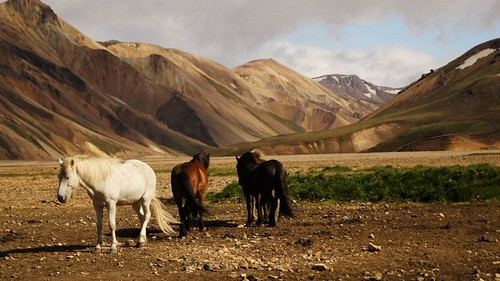
Icelandic horses (with the most fabulous 80s hair) in front of the Brenninsteinsalda Rhyolite Mountains. Photo courtesy of Rebecca Wolsey (PhD Student, Open University, UK).
A key element to the school was the ability to use in-situ techniques to investigate how life can survive hostile environments. Iceland was a great place to find hostile environments (just ask the sheep from the lava cave), and our expert field guides and scientists were prepped to teach us the art of finding life. One method for looking for life in volcanic and glacial environments is to detect the generic biomarker, Adenosine triphosphate (ATP). ATP is the primary source of free energy in all living cells. ATP is produced only in living cells during photosynthesis and cellular respiration and consumed in cellular processes. It is a key indicator of cellular activity, and a major biomarker when trying to find habitable conditions for life, since all known living organisms require ATP.

The road to Mordor… I mean, Landmannalaugar. Photo courtesy of Christina Richey
Three sample sites were chosen for in-field detection of ATP utilizing our bioluminescence assay kits: an older lava field, a newer lava field, and a glacier. Additionally, hot springs were available at our older lava field site. David Cullen, from Cranfield University, was our expert in ATP analysis, and guided us on our preparations and sampling throughout the field trips. The students were divided into 4 groups. Each group was given the opportunity to design their experimental sampling strategy and collect the samples. Samples were then returned to Skógar, where analysis was run, and each group had 1 day to write their report based on the results from their ATP analysis. The trip to Skógar was also enjoyable due to Skógafoss, a waterfall situated on the cliffs of the former coastline where we’d break for coffee before the return trip to Hvolsvöllur each evening. Each group included 1-2 experts within the field to aid in sample collection and answer questions. Due to the time constraints, these results were meant to be an introduction into ATP analysis, and a tool for understanding the limitations and compromises that the fieldwork entailed. Our group chose to study whether there were any obvious trends in biological activity between older and younger lava fields and how tephra deposits on glaciers compared with those from lava fields.
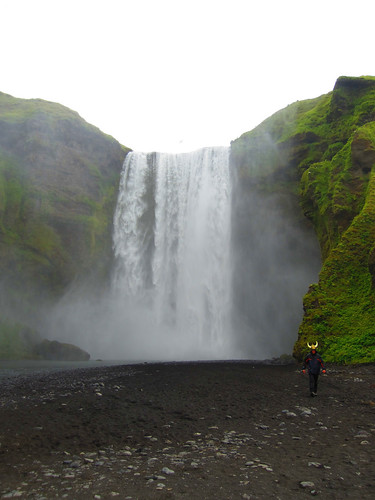
Skógar, where we met to drop our samples at the lab site for analysis. Photo courtesy of Ben Duffus (PhD Student, Montana State University).
Our first detection site was Landmannalaugar, home of the Laugahraun lava field and Brenninsteinsalda Rhyolite Mountain and near the volcano Hekla. Laugahraun is an obsidian lava field from an eruption that occurred in 1477 AD. Due to the age of the lava field, vegetation is visible, as lava is a trap for wind-blown sediments and materials. The area is full of hydrothermal reactions, and it is the highest temperature geothermal field in Iceland. Hot springs are in the area, and our group chose to collect samples from both the lava field and hot springs. The multi-colored Brenninsteinsalda Rhyolite Mountains were stunning, as this area has the largest collection of rhyolite in Iceland. Melting in the crust can form rhyolite, but it can also form from crystallization of another type of rock, basalt.

Landmannalauger. Photo courtesy of Ben Duffus (PhD Student, Montana State University).

One of the Brenninsteinsalda Rhyolite Mountains. Photo courtesy of Christina Richey.
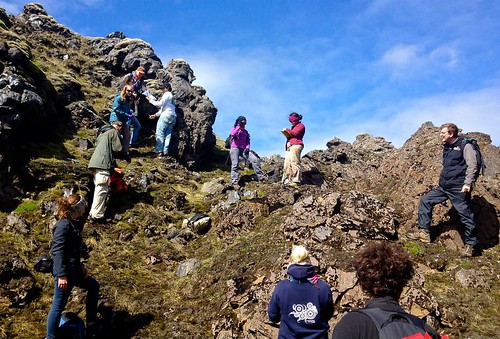
Our group collecting a sample from the Laugharaun lava field for ATP analysis. Photo courtesy of Christina Richey.
Our second detection site was the Fimmvörðuháls lava field. The majority of our time was actually spent hiking towards the lava field, and the views as we climbed upward were absolutely stunning (though, I’ll admit, petrifying a few times). Fimmvörðuháls is the area between two glaciers: Eyjafjallajökull and Mýrdalsjökull. The 2010 eruption of the Eyjafjallajökull volcano began in this area, which is covered in still steaming lava. Eyjafjallajökull’s main eruption on April of 2010 caused a jökulhlaup (glacial melt water flood) to occur, forcing the evacuation of hundreds. As the melt water seeped into the volcanic vent, explosive eruptions began to occur, and this lead to the volcanic ash cloud that shut down northwest European airspace for several days.
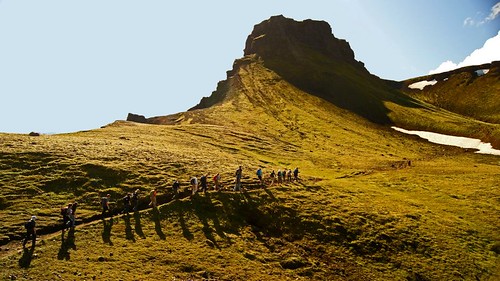
The long hike up to the Fimmvörðuháls lava field. Photo courtesy of Rebecca Wolsey (PhD Student, Open University, UK).
Eyjafjallajökull is situated beside another subglacial volcano, Katla, which is larger and known for it’s much more powerful eruptions. Each of the eruptions of Eyjafjallajökull have preceded an eruption of Katla, however, Katla has not displayed any unusual activity. Our group collected samples of lava that were in sunlight, obstructed from the sun, and also near water, to try to detect ATP. An exciting moment within our day-long hike and sample collection came with the discovery of a baby fern growing in the lava field. Here’s a group of scientists, looking for life in very hostile conditions, and we found it growing in a still-steaming lava field. Pretty amazing.
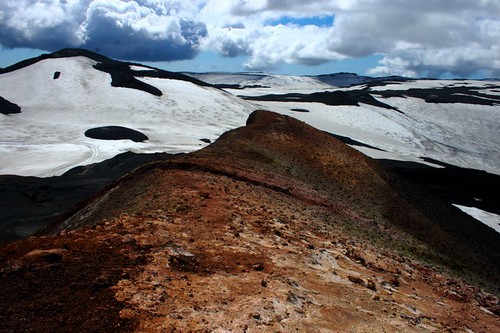
The newer (2010) lava field we used for ATP sample gathering. Photo courtesy of Sophie Nixon (PhD Student, University of Edinburgh, UK).
Our last sampling site was the Solheimajökull glacier, which is the southwestern outlet of the Mýrdalsjökull icecap. The icecap covers Katla, and is currently covered in ash from the 2012 eruptions, as well as previous eruptions of both Eyjafjallajökull and Katla (Katla’s last eruption was in 1918). The glacier is full of surprises, and our excellent guides help us maneuver our way around the ice cap. These surprises included crevasses, fractures, and moulins, which are streams for water to flow, typically to the base of the glacier. These waters can move rapidly, and are stunning to be near, but also a nice reminder to watch where you’re stepping. We were equipped with ice picks and crampons (awesome steel-spiked shoes that are fun to walk and run and jump in, once you get the basic handle of them). We collected our tephra-samples, and also a few glacial-water samples, and headed back to Skógar to await our analysis and results.

Solheimajökull glacier. Photo courtesy of Rebecca Wolsey (PhD Student, Open University, UK).

Crevasses along the Solheimajökull glacier. Photo courtesy of Sophie Nixon (PhD Student, University of Edinburgh, UK).
Part IV: Presenting our results, and enjoying Iceland

Two of the four groups after hiking to the Fimmvörðuháls lava field. Photo courtesy of Rebecca Wolsey (PhD Student, Open University, UK).
We travelled from Hvolsvöllur to Reykjavik, where we spent the day at The University of Iceland interpreting our results and preparing our reports and presentations. Due to the diversity in each group, our results ranged from biological implications to astronomical applications and felt extremely put-together and thought out for a 12 hour timeline. Within our group, the older lava field showed by far the highest concentrations of ATP, which should be considered as no surprise, given the timeline for vegetative growth was extended by a few hundred years, compared to the newer lava field. The sedimentary samples contained more ATP than our water samples, and out of our water samples, the still-water samples had higher level of ATP compared to the running water samples (again, expected, as the still water would be able to accumulate higher level of nutrients and provide a more stable environment). While these samples were very preliminary and meant to be a learning opportunity, the scientific importance of our implications and the ability to work through limiting factors for in-situ experiments was extremely worth-while. I am used to be in a controlled lab environment, and the opportunity to work within the field, where something as simple as a pollen-filled breeze can wreak havoc on your results, was a new experience.
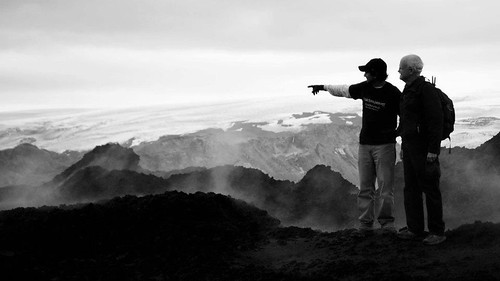
Sanjoy Som, A NASA Postdoctoral Program fellow at NASA Ames, discusses volcanology with David Des Marais, a senior scientist also at NASA Ames, while on top of the Fimmvörðuháls lava field. Photo courtesy of Rebecca Wolsey (PhD Student, Open University, UK).

We came close, but lost no one while participating in our grand schooling/adventure. Photo courtesy of Rebecca Wolsey (PhD Student, Open University, UK).
After our reports were completed and our presentations…well… presented, we had the opportunity to also see some of the sites of Iceland from a slightly tourist-y perspective. Many of us went whale watching on a midnight cruise one evening, where we were able to see several Minke whales, as well as Puffins. The Atlantic Puffin is a cute bird, or as we started calling it, “a potato with wings”. Several islands off the coast of Iceland are their mating grounds where they come to each summer to nest. We also enjoyed a farewell dinner and thanked our organizers for the fantastic learning experience. I can honestly say the Nordic-NASA “Water, Ice, and the origin of Life in the Universe” Astrobiology Summer School was an once-in-a-lifetime experience. Between the knowledge I gained, the scientific experience I would not have received elsewhere, the challenging, but breathtaking, hikes, and the views of a truly beautiful country, I fell in love with Iceland, and can’t wait to one day return.

One last random shot from the Icelandic country roads. Photo courtesy of Christina Richey.


